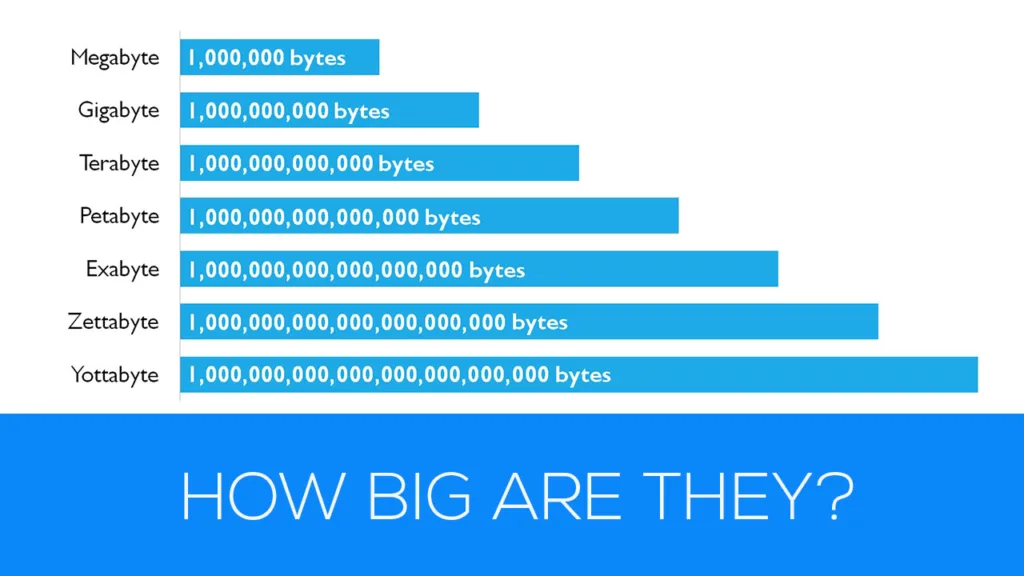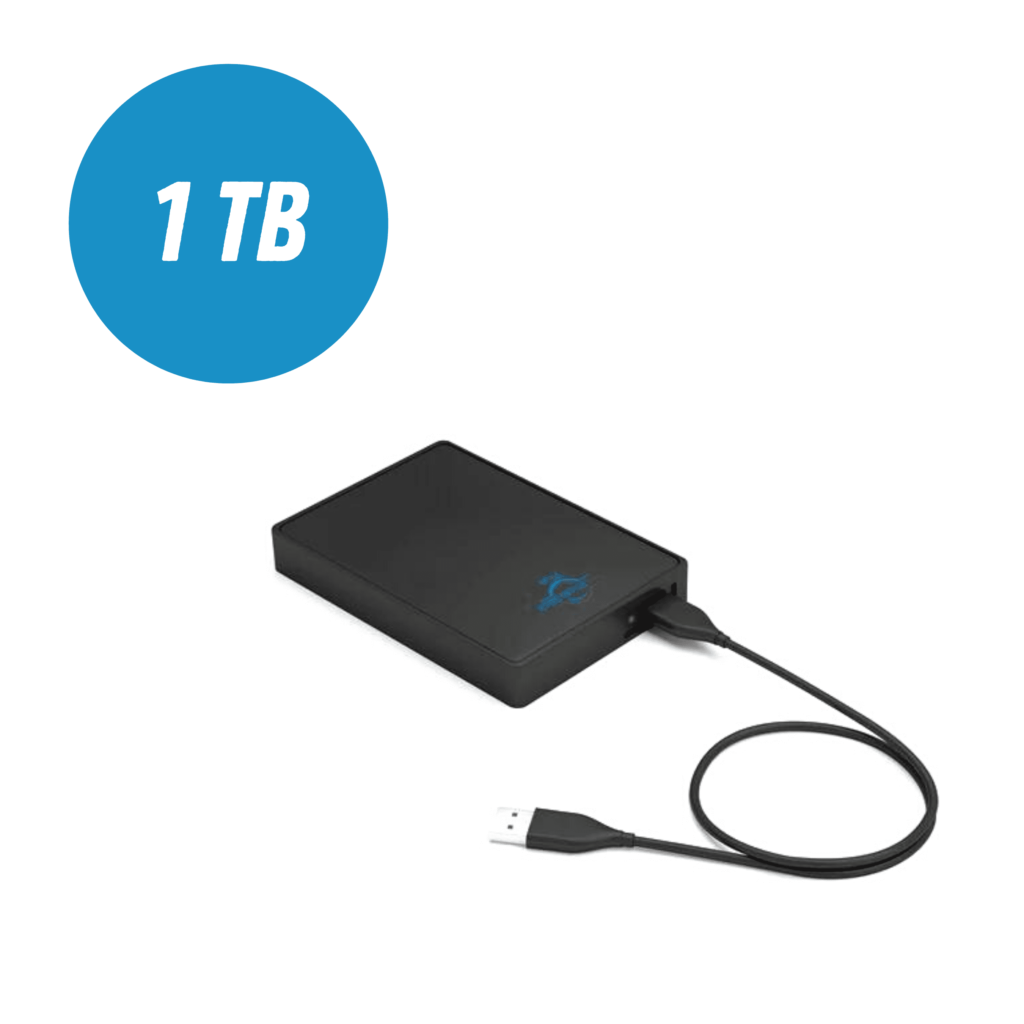In the world of technology, the term “terabyte” has become a common word. It is used to describe the storage capacity of computers, hard drives, and other digital devices. But what exactly is a terabyte, and how big is it? In this blog post, we will explore the concept of terabytes and give you an idea of how much data a terabyte can hold.
A terabyte (TB) is a unit of digital information that represents one trillion bytes or 1,000 gigabytes (GBs). It is used to describe the storage capacity of digital devices such as computer hard drives, flash drives, and memory cards. A terabyte is a massive amount of data, and it can store a vast number of files, including high-resolution photos, videos, music, and documents.
There are two types of terabytes – binary and decimal. The binary terabyte is also known as a tebibyte (TiB), and it is equal to 1,099,511,627,776 bytes or 1,024 gigabytes. The decimal terabyte is equal to 1,000 gigabytes, which is the standard used by most manufacturers.
To put this in perspective, a binary terabyte can store about 1,099,511,627,776 characters of text, 250,000 high-quality photos, 250 movies, or 500 hours of HD video. On the other hand, a decimal terabyte can store approximately 1,000,000,000,000 characters of text, 238,418 high-quality photos, 238 movies, or 476 hours of HD video.
The size of a terabyte depends on the type of data being stored. For example, a terabyte can store approximately:
– 250,000 photos taken with a 12MP camera
– 250 movies or 500 hours of HD video
– 6.5 million document pages, commonly stored as Office files, PDFs, and presentations
– 2,000 hours of music or 100,000 songs
A terabyte is a massive amount of data, and it can store a vast number of files, including high-resolution photos, videos, music, and documents. The size of a terabyte depends on the type of data being stored, and tere are two types of terabytes – binary and decimal. While a decimal terabyte is worth one trillion bytes, a binary terabyte (tebibyte) is worth 1,099,511,627,776 bytes. So, if you are planning to buy a digital device with a terabyte of storage, you can rest assured that it can store a lot of data.
Comparing 1000 GB to 1 TB
When it comes to data storage, there are different units of measurement that may be used. Two of the most common standards for measuring digital storage are the decimal and binary systems. The decimal system is based on powers of 10, whie the binary system is based on powers of 2. This can lead to confusion when it comes to comparing storage capacities.
In the decimal system, 1 terabyte (TB) is equal to 1,000 gigabytes (GB). This is the standard used by most manufacturers of storage devices, as well as by operating systems such as Windows and macOS. So if you buy a hard drive or flash drive that is advertised as having a capacity of 1 TB, you can expect it to have approximately 1,000 GB of usable storage space.
However, in the binary system, 1 TB is equal to 1,024 GB. This is because each unit of storage in the binary system is a power of 2, rather than a power of 10. This can be confusing, as it means that a storage device that is advertised as having a capacity of 1 TB according to the decimal system will actually have slightly less storage space when measured using the binary system.
To put it into perspective, here are the approximate equivalent values of 1 TB in different systems:
– Decimal system: 1 TB = 1,000 GB
– Binary system: 1 TB = 1,024 GB
– SI system (used for scientific purposes): 1 TB = 10^12 bytes
– IEC system (used for binary-based storage devices): 1 TB = 2^40 bytes
To sum up, while 1 TB and 1,000 GB may be used interchangeably in the decimal system, it’s important to keep in mind that the binary system uses a slightly different measurement. This means that if you’re working with large amounts of data, it’s important to be aware of which system is being used to avoid confusion and ensure that you have enough storage space for your needs.

How Much Storage Does 1 TB Represent?
When it comes to digital storage, 1 terabyte (TB) is considered to be a significant amount of space. In fact, it is equal to 1,000 gigabytes (GB), or 1 million megabytes (MB). To put this into perspective, a standard laptop or desktop computer typically comes with a hard drive that ranges from 250 GB to 1 TB.
So, is 1 TB a lot of storage? The answer depends on your individual needs and usage. For the average user, 1 TB is more than enogh space to store a large collection of photos, videos, music, and documents. In fact, 1 TB can store approximately 250,000 photos taken with a 12-megapixel camera or 250 movies (assuming each movie is around 4 GB in size).
For those who work with large files or media, such as graphic designers, video editors, or gamers, 1 TB may not be enough. These professionals often require several terabytes of storage to store their work and projects.
1 TB is a significant amount of storage and is suitable for the majority of users. However, it’s always a good idea to assess your individual needs and usage before determining how much storage you need.
Cost of 1 Terabyte of Data
A terabyte is a unit of digital inormation that represents one trillion bytes. This is the standard definition of a terabyte in decimal notation. However, in binary notation, which is used by computers, a terabyte is equivalent to 1,099,511,627,776 bytes. This is because computers count in powers of two, rather than powers of 10.
To put this into perspective, a terabyte of data can hold a vast amount of information. It is equivalent to approximately 1,000 gigabytes (GB) or 1 million megabytes (MB). This means that you can store a huge amount of files, such as photos, videos, music, and documents, on a terabyte hard drive or other storage device.
To give you an idea of how much data a terabyte can hold, here are some examples:
– Around 250,000 songs in MP3 format
– Over 300 hours of high-definition video
– Approximately 2,000 hours of standard-definition video
– Up to 1,000,000 photos (depending on the quality and size of each image)
It is worth noting that the amount of data a terabyte can hold also depends on the file format and compression used. Some file formats, such as JPEG images or MP3 audio files, can be compressed to take up less space on a hard drive. Conversely, some file formats, such as uncompressed video or high-resolution images, can take up much more space.
A terabyte of data is a significant amount of digital storage capacity that can hold a vast amount of files and information. As technology continues to evolve, we may see even larger storage capacities become commonplace in the future.
Cost of 2 Terabytes of Storage
2 terabytes (TB) is a unit of digital storage capacity that equals 2 trillion bytes. To break it down even further, 1 byte is the equivalent of 8 bits, which means that 2TB is the same as 16 trillion bits. This amount of storage space can hold an immense amount of data, including thousands of high-resolution photos, hundreds of hours of HD video, and even entire collections of music or movies.
In practical terms, a 2TB drive can store abut 100,000 songs in high-quality MP3 format, or 150 full-length movies in high-definition. In addition to personal media collections, 2TB of storage can be used to store a vast amount of business files, such as Word documents, spreadsheets, and presentations.
2TB is a massive amount of storage space that can accommodate a wide range of digital content. Whether you’re a home user or a business professional, a 2TB drive can provide ample space for all your digital needs.

Conclusion
A terabyte is a massive amount of storage capacity that can hold a vast quantity of data. However, it’s important to note that there are two different standards used to measure a terabyte, the decimal standard and the binary standard. The decimal standard states that a terabyte is equal to 1,000 GB, while the binary standard states that a terabyte is equal to 1,024 GB. This difference of 24 GB may not seem like much, but it can represent a substantial amount of data. It’s important to be aware of wich standard is being used when purchasing or measuring storage capacity.
With one terabyte of storage, you can store a massive amount of data, such as 250,000 photos, 250 movies, or 6.5 million document pages. A 2TB drive can hold even more, such as 100,000 songs, 150 movies, and countless business files. As technology continues to advance and data becomes more and more important, the need for terabytes of storage will only continue to grow.
A terabyte is an incredibly powerful tool for storing and organizing data. By understanding the different standards used to measure a terabyte and the vast amount of data that can be stored, individuals and businesses can better prepare themselves for the future of data storage.
